How To Define Success? Designival 2014 — Reviewed
What do top designers include in their recipe for success? Architect Matthew Ashton goes to this year’s Designival to find out…
How to define success… Integrity? Turnover? Satisfaction with your surroundings, process, or clients? This question seemed a preoccupation of the speakers at Designival, Liverpool’s one-day festival of design, hosted by Camp & Furnace last Friday.
For first speaker Jonathan Sands, without question the primacy of his agency Elmwood is paramount. Joining the studio as a junior, he masterminded a management buy-out at the tender age of 28, building the business into a worldwide player with major brand clients. Certainly a business-focussed speaker, but equally candid in speaking of the trials of building a studio, viz “…if you’re not making mistakes, you’re not pushing yourself” from the Sands school of tough love.
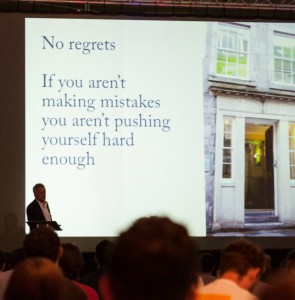
Tom Evans of BleepBleeps took the entrepreneurial baton into the arena of product development. From a graphic design background, Evans is pioneering responsive, humane technology under the auspices of the ‘internet of things’. Certainly a great speaker — who also managed to master the AV (which remained problematic for the other speakers) — Evans’ talk was a confident and impressively synchronized spoken-word and visual image presentation.
The audience were left with a fullsome insight into building the creative team, managing collaborative processes and the journey of product design and development. Q&A’s can be trying, but in this respect Evans was responsive and engaged; asking questions of the audience.
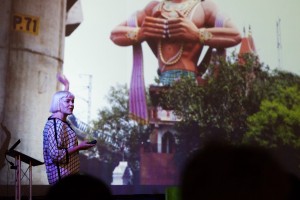
And so to Morag Myerscough of London-based Studio Myerscough. At this point, the author must confess a prejudice: this cannot be an impartial review. In common with half the audience, I’m in love with Morag Myerscough. Her work spans the arenas of public realm commissions, design and delivery of event venues, working with other artists and makers as part of Supergroup, and several collaborations with architects, most notably with the practice Allford Hall Monaghan Morris. Myerscough’s talk was personal, meaningful and without doubt the highlight of the day. Her enthusiasm for colour, type and form are evident, but her passion for people, demonstrated through an ongoing process of engagement at the core of her practice, was refreshing.
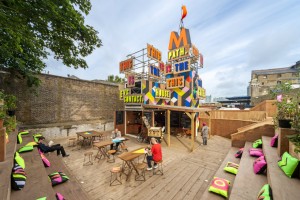
Myerscough reflected that her satisfaction is derived from her making, her surroundings, and her collaborators. Creativity seems central to her sense of being; for this reason, she remains in tight control of her working techniques, deliberately compact in her team and environment, and a stark contrast to Jonathan Sands, for example. What’s not to love?
Engagement is of equal significance to designer Jonathan Barnbrook, whose work often very directly addresses social and political issues in a disarming way. Described by Designival as “designer, typographer and provocateur”, his roster of clients is significant, not least David Bowie, for whom he produced the much-talked-about The New Day artwork and which unsurprisingly dominated the first half of the talk. Barnbrook was brave enough to show some of the work that didn’t make it, and it is always enlightening to follow the process of a commission, especially with such a client as Bowie.
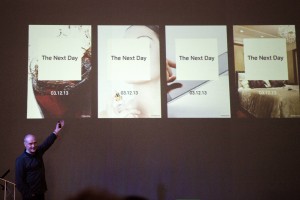
The second portion of the talk took the form of an ‘In Conversation’, and explored Barnbrook’s practice, from the composition of the studio and working methodology, to how to work ethically in a highly contingent sphere of work. He seemed happy to talk about a degree of creative autonomy for designers in his studio, frequently a bone of contention.
The final slot is traditionally reserved for the keynote speaker; unfortunately Harry Pearce of Pentagram cancelled, leaving a difficult space to programme. At very short notice, Matt Baxter and Dom Bailey of London-based design consultants Baxter and Bailey stepped up, and should be commended for doing so.
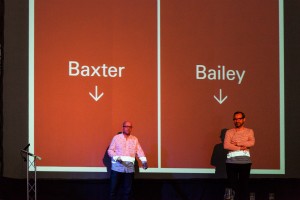
Their talk was frank and refreshingly light-hearted, and as a happy accident seemed to respond to the day, covering business strategy, creative intent and ethical concerns. Previous experience at creative agency 300million, and work apart in other locations, had led Baxter and Bailey to consider more strategically their target clients. They sought to reinforce the importance of sharing the values of a client, which echoed Jonathan Barnbrook, though their scope of work seems to avoid large brands in favour of the arts sector.
So how did Designival define success? For Sands, it’s making his agency number one by propelling a client’s product or message to number one. For Baxter and Bailey, it’s building a business which balances their quality of life with work in sectors they care about. Barnbrook has carved out a niche with some high profile clients, and there is no doubt his activism reinforces his practice. Myerscough remains in complete creative control of her process, often including the output and delivery of a concept, which seems to marry with the motivation behind Tom Evans’ work.
Perhaps these are mutually exclusive definitions for success; what is certainly common amongst these speakers is aligning personal motivation with that of your studio process.
Matthew Ashton is an architect and co-founder of MgMaStudio/ architecture, established in Liverpool 2011
More at designival.com
Images/video top to bottom: BleepBleeps; Jonathan Sands; Morag Myerscough; Movement Cafe, deign by Studio Myerscough; Jonathan Barnbrook discussing rejected Bowie album designs; Baxter and Bailey. Courtesy Designival 2014





